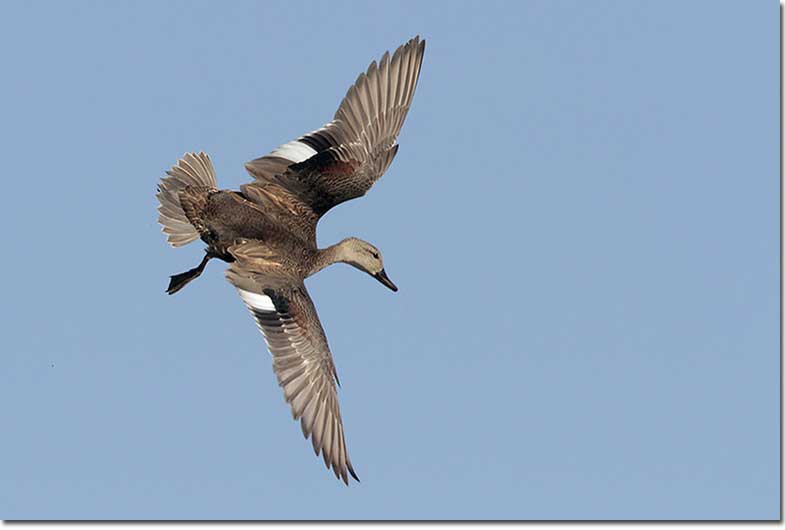
Ducks are beautiful birds that grace our lakes and wetlands. Better yet, they are also some of the easiest birds to watch!
A lot of ducks make their home in North America, including in the state of South Carolina. In this southern state, we can watch hundreds of ducks in coastal marshes and other wetlands!
Have you seen many ducks in South Carolina? We bet you’ve seen quite a few waterfowl species in South Carolina, but how many could you identify?
Most Common Duck Species in South Carolina
Based on eBird data, we created a list showing the most common duck species in South Carolina.
The ducks are arranged from most common to least common, and we also included key information about their habitats and behaviors.
But be warned, this list includes only ten waterfowl species. There are more ducks in South Carolina, but these are the most common ones.
Mallard
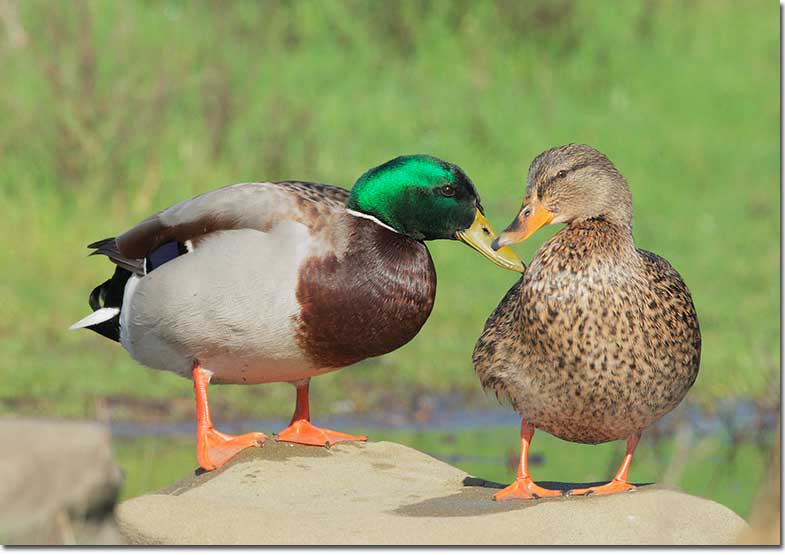
Scientific name: Anas platyrhynchos
Length: 23 inches
Wingspan: 35 inches
Mallards are the most familiar duck species. For lots of folks, this is “the duck”. They have been domesticated for centuries and lots of them are fed at urban ponds and lakes.
However, make no doubt about it, Mallards are wild birds that also live in lots of wild and remote areas in most of North America. The males have a dark green head, narrow white collar, yellowish beak, and dark brown chest.
Female Mallards, though, can be trickier to identify. They are brown with some paler brown and dark markings, and have a gray-brown neck and head with a dark cap, and a dark line through their eyes.
In flight, we can also recognize female Mallards by their pale tail, and two white wing bards bordering a green-blue wing patch.
In addition to eating bird food and vegetables, Mallards dabble in shallow water for plant matter and small creatures.
Key identifications:
- Big duck with a glossy green head and yellowish beak.
- The female has a dark center mark on her orange beak.
- Short, pale, or white tail.
Wood Duck
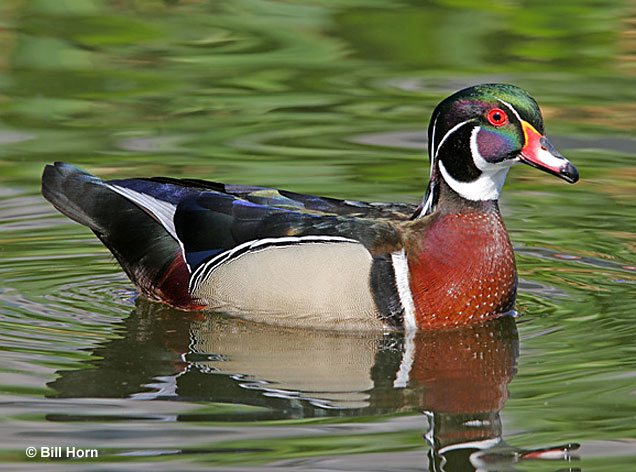
Scientific name: Aix sponsa
Length: 18.5 inches
Wingspan: 30 inches
Wood Ducks are seriously ornamental birds. These cute, slender, long-tailed ducks prefer wooded swamps and other wetlands in forested habitats. The males have a rounded head with a dark green crest, black and white face, short red beak, and jade green back. They also have bright buff flanks and a chestnut chest and undertail.
Female Wood Ducks grayish-brown birds that aren’t nearly as fancy but can still be recognized by their blocky head, white spectacles, slender shape, and mostly dark wings.
Wood Ducks usually occur in pairs but can also form small flocks that forage for acorns, plant matter, and small creatures in and near water. We often hear these ducks give their odd, squealing whistle vocalization before we see them.
Key identifications:
- Slender duck with a longish tail and a blocky head.
- Ornate plumage a short, reddish beak.
- Dark wings with a narrow white line on the base of the trailing edge.
Hooded Merganser
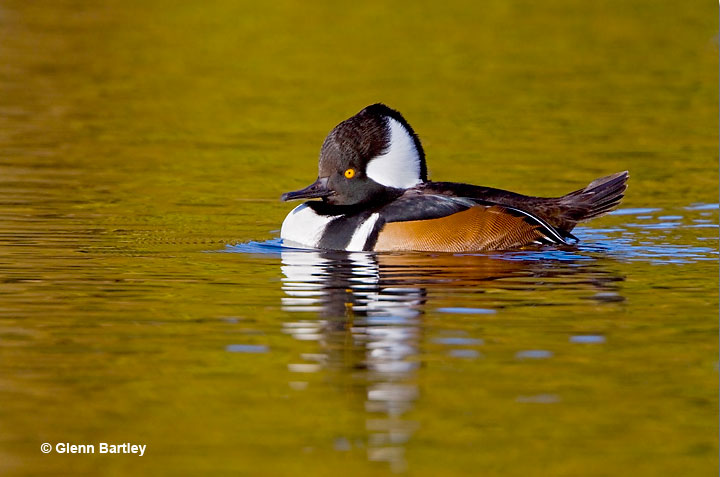
Scientific name: Lophodytes cucullatus
Length: 18 inches
Wingspan: 24 inches
The Hooded Merganser is one of the prettiest little ducks in North America. Breeding males are handsome ducks with a rounded black and white head, and black neck and back. Their jet black upperparts combine nicely with two black marks on a white chest, and rich, pumpkin-colored flanks.
Females aren’t as colorful but are still pretty in their own way. These brown-gray birds have a slender, yellowish beak, and a deep, caramel-colored, rounded crest.
Both sexes also have a longish, somewhat pointed tail, and small white markings on the base of their slender dark wings.
Hooded Mergansers dive for crayfish, small fish, and other small creatures in wooded swamps and marshes. We don’t see them flock together as much as other ducks do, and they usually occur as pairs.
They mostly breed in forests of southern and western Canada, and the northeastern USA, but winter in wooded wetlands.
Key identifications:
- Small duck with a small, slender beak.
- Blocky or rounded head.
- White belly and a bit of white on the base of narrow wings.
Bufflehead
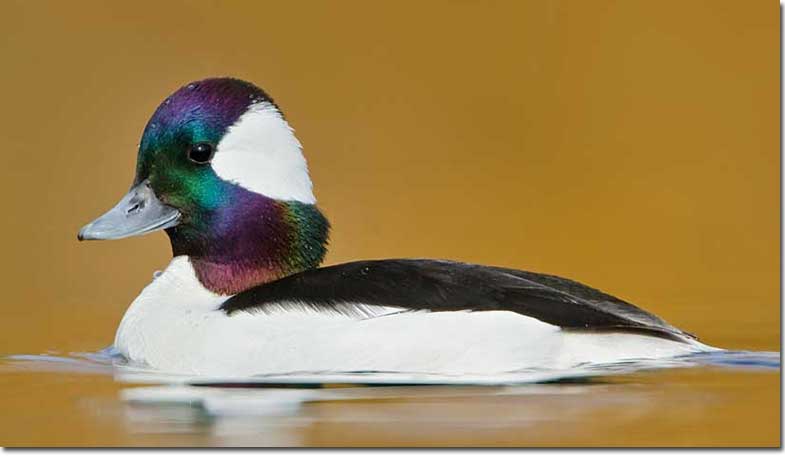
Scientific name: Bucephala albeola
Length: 13.5 inches
Wingspan: 21 inches
Buffleheads are small, cute ducks with rounded heads and stout little beaks. Males are bold, black and white birds with a big white patch on their head. In good light, their head also has green and purple iridescence.
Female Buffleheads are more gray-brown with a white belly, and have a smaller white head patch.
During their fast flight, Buffleheads show a white patch in their wings although the female’s white patch is smaller. These ducks breed on northern, forested lakes in Alaska, Canada, and parts of the northwestern USA.
Like some other small ducks, they need tree cavities for nesting and often use holes made by Northern Flickers.
For the winter, they find their way to South Carolina’s coastal waters and lakes, big rivers, and reservoirs.
Buffleheads dive to forage for mollusks and other small creatures. They also occur in flocks, sometimes with goldeneyes and other diving birds, especially in winter.
Key identifications:
- Small chunky duck with stout gray beak.
- Rounded head with a bold white patch.
- Mostly black and white or grayish with a white belly and small white wing patch.
Gadwall
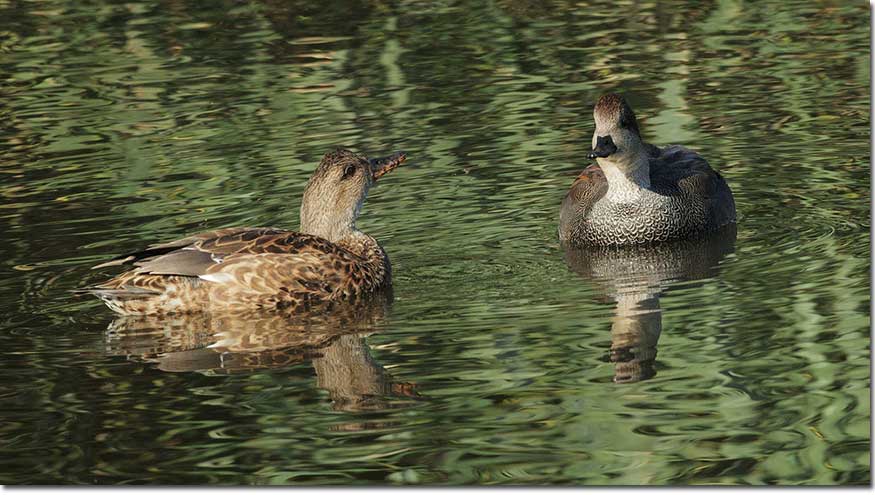
Scientific name: Mareca strepera
Length: 20 inches
Wingspan: 33 inches
Gadwalls are medium-sized ducks with a small white patch on the base of each wing. Males are gray ducks with a paler grayish head, some brown feathers on their wings, and a black rump, tail, and undertail.
Female Gadwalls look a lot like female Mallards and have gray-brown plumage with buff markings, and a paler grayish head. Like hen Mallards, they also have an orange and black beak but it is mostly gray on the upper part of the bill.
In flight, both sexes show white bellies, the small white mark on their wing, and much white on their underwings.
Gadwalls forage for seeds and other plant matter in and near shallow water.
These ducks breed in shallow wetlands in central and western Canada, and in various parts of the northern and western USA. Their wintering grounds include southern and eastern side of North America.
Key identifications:
- Male is mostly gray with black rear end.
- Female has grayish head and gray and orange beak.
- Small white patch on base of wing.
Green-winged Teal
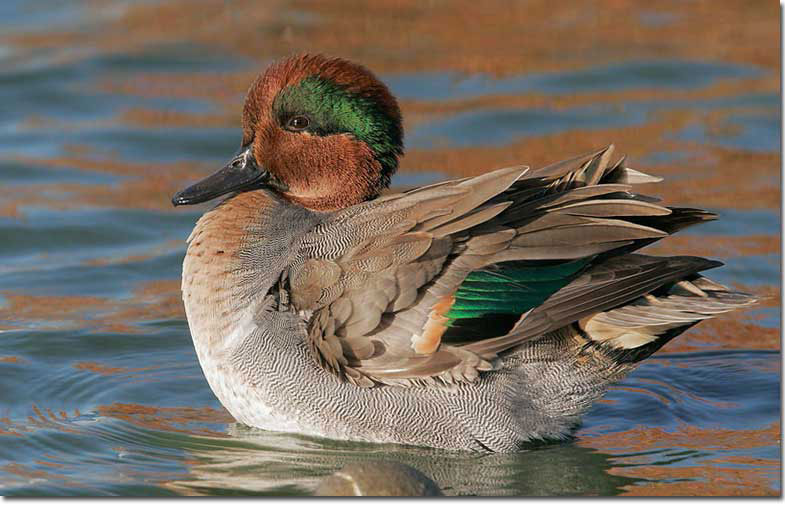
Scientific name: Anas crecca
Length: 14 inches
Wingspan: 23 inches
Green-winged Teals are small waterfowl with a smallish, dark beak, and a dark green patch at the base of each wing. Males of these cute little ducks are mostly gray and have a chestnut head with a dark green patch, speckled, buff chest, and narrow white bar near their chest.
Females are mostly mottled brown with a dark line through each eye. Both sexes have a buff mark on the edge of their tail, and show a white belly in flight. Green-winged Teal like to forage for plants and small creatures in the shallow water of marshes and other wetland habitats.
They breed in Alaska, Canada, and the northern USA, and winter in a variety of wetland habitats in some parts of southern Canada, and most of the USA.
Although this small duck species can form flocks, we often see them in pairs or only in small groups. They also migrate north later than other duck species.
Key identifications:
- Very small duck.
- Buffy mark along the edge of each side of its tail.
- Small dark beak and dark green patch edged with buff on its wings.
Ring-necked Duck
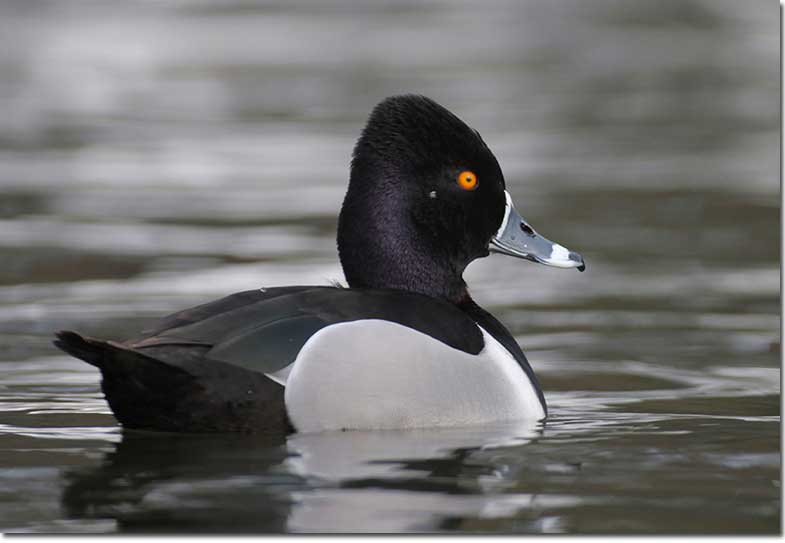
Scientific name: Aythya collaris
Length: 17 inches
Wingspan: 25 inches
Ring-necked Ducks are one of those birds that don’t have the best of names. While males do have a brown ring on their necks, it blends in with their black neck and can be really hard to see.
Ring-necked Ducks should really be called, “Ring-billed Ducks”! The males are best recognized by the white ring near the black tip of their dark gray beak, and their combination of a black back, head, neck, and chest. They also have gray sides and a white mark near their black chest.
Female Ring-necked Ducks are plain, brownish birds with pale bellies and narrow white spectacles on a grayish face. They also show a bit of white on their face, near the base of their bill.
Ring-necked Ducks dabble and make shallow dives for a variety of food items. They like to eat plant matter, insects, and other small aquatic creatures. We find them in a variety of shallow wetlands in much of North America.
Key identifications:
- Male has black back, head, and chest.
- Gray sides with white near the black chest.
- Female has narrow white spectacles on gray face.
Lesser Scaup
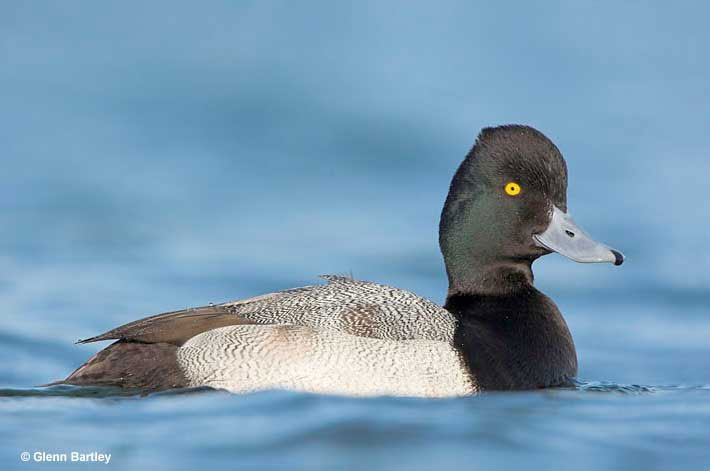
Scientific name: Aythya affinis
Length: 16.5 inches
Wingspan: 25 inches
Lesser Scaups are smallish or medium-sized diving ducks with a blue-gray beak. Males have a black head with dark green highlights, black chest, and black rear end, pale gray back, and white sides and belly.
Female Lesser Scaups are dark brown with a pale belly, and a white mark on their face. Both sexes have the back part of the head more pointed than the front part. That field mark might not sound like much but it’s one of the best ways to tell them from the extremely similar Greater Scaup!
Lesser Scaups dive to forage in lakes, reservoirs, and coastal bays for mollusks, crustaceans, and other aquatic creatures. In migration and winter, they often occur in flocks that can number in the hundreds!
As a common winterer, Lesser scaups can be seen in southern parts of the United States.
Key identifications:
- Bluish beak.
- Slightly peaked on the back part of its head.
- Male has black chest, gray body, and dark head, female has a white mark on the front of her face.
Northern Shoveler
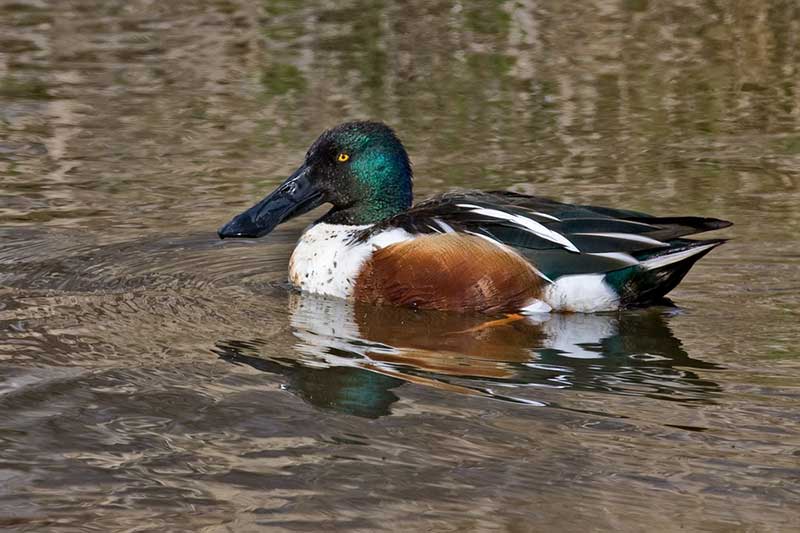
Scientific name: Spatula clypeata
Length: 19 inches
Wingspan: 30 inches
Northern Shovelers are a distinctive duck species with a big, prominent beak. Males have striking plumage with a dark green head, and white and chestnut underparts. They are also white and gray on their back, have orange legs, and show blue shoulders in flight.
Female Northern Shovelers are tawny-brown ducks with lots of buff markings, and an orange and gray beak. Both sexes also have a pale tail.
These pretty ducks like to float in marshes and other shallow wetland habitats. They often form flocks and we can see them foraging with Blue-winged Teals and other dabbling ducks. Like many other duck species, Northern Shovelers feed on a combination of plant matter and small aquatic creatures.
This species breeds in shallow wetlands in Alaska and western and central Canada but winters in South Carolina.
Key identifications:
- Over-sized, flat beak.
- Male has a white breast, red-brown sides and belly, and dark green head.
- Female has a pale tail and orange and gray beak.
Red-breasted Merganser
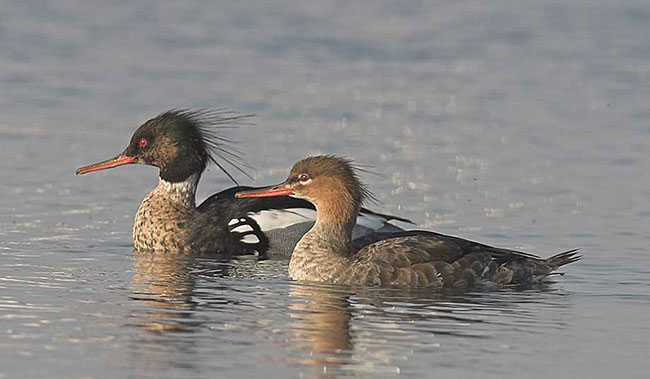
Scientific name: Mergus serrator
Length: 23 inches
Wingspan: 30 inches
Red-breasted Mergansers are big, slender ducks with long, thin beaks. Unlike some ducks we know, you won’t find them paddling around ponds and looking for handouts.
This duck is built for speed! Red-breasted Mergansers can fly at 80 miles per hour! They aren’t that fast when swimming underwater but are still quick enough to catch young trout and other fish.
Male Red-breasted Mergansers have a dark green head, broad white collar, and a dark brown chest border with black and white markings. They also have a black and white back, gray sides, and a white belly.
Females are mostly gray with a tawny head and a white belly. Both sexes have reddish beaks, a double crest, and white on the base of their pointed wings.
Red-breasted Mergansers are winterers in South Carolina; you might see them in big flocks.
Key identifications:
- Big, slender duck with a narrow reddish beak.
- Tawny or dark green head with a double crest.
- Much white on the base of long wings.
Frequently Asked Questions
What is the most common duck in South Carolina?
The most common duck in South Carolina is the Mallard. According to eBird data, this familiar duck is seen in South Carolina more than any other duck species.
What kind of ducks swim underwater in South Carolina?
The kinds of ducks that swim underwater in South Carolina are the Hooded Merganser and Red-breasted Merganser, and diving ducks like the Bufflehead, Ring-necked Duck, and Lesser Scaup.
Are Muscovy ducks in SC?
No, Muscovy Ducks are not in SC. However, on occasion, escaped domestic Muscovy Ducks might be seen.
What is the rarest duck in South Carolina?
The rarest duck in South Carolina is the Tufted Duck. This rare vagrant from Europe has been seen on very few occasions in South Carolina.
Are there black ducks in South Carolina?
Yes, there are American Black Ducks in South Carolina. However, they are not as common as other duck species in the state.

